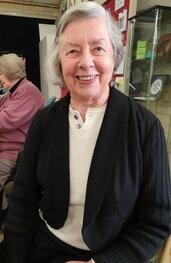 Pat Grummet
Pat Grummet This is a first for this blog. I often quote others but I was privileged
to be among a number of interviewees for a short project that the
fabric artist Pat Grummet undertook recently. She, at the age of 87,
is a member of a group looking at various aspects of textiles and
life, each of whom presents a short paper for discussion. Pat
happens to be my mother-in-law and has been a creative, artistic
and spiritual companion.
Her paper, Dress Ups, follows.....
For a small child the dress-up box can occupy many happy hours. There are endless treasures to be discovered and characters to be created through combining, sometimes incongruously to the adult eye, a random selection of elements. A good dress-up box can contain hats, aprons, skirts, discarded clothing, pieces of fabric, bed-sheets, scarves and shawls, costume jewellery, handbags, hats, shoes, glasses.
A child from four to five years-old can create a magical world of make-believe. However, role-playing is important for the child’s character development. It engages the imagination, builds vocabulary, develops sensory and motor skills, develops empathy and cooperation with others. A child, female or male, can explore gender identities, vocal range, and memory.
I spent some happy hours in lock-down with a number of friends, reminiscing about dress-ups in their own lives. There were stories of children who loved to dress up, and the ones who hated it; some would enthusiastically wear their dress-ups in public, and some were too embarrassed to be seen by others; of mothers who could sew, and those who couldn’t.
School Book Week was an opportunity to be one of the characters a child related to, dance classes and theatre productions were a chance to be someone in another story. There were recollections of cowboys and Indians, Annie Oakley, animals, insects, TV and movie characters. The advent of television brought visual impressions of character, and in a way put parameters around “what ought to be” in terms of colour and movement. Commercial enterprises saw the chance to exploit the decrease of sewing skills in the wider community.
More interesting, I found, was the collection of random pieces that could be thrown together to express mood, temperament, and fit a spontaneous story-line. Friends spoke lovingly of long, swirly skirts – red, black, yellow, pretty floral. A red velvet cape could be Red Riding Hood or Superman, or a magician – perhaps with the addition of a hat. Scarves and net curtains could be tied around the head as pretend hair, beach towels created sheiks. Superior ladies wore hats, gloves, and perhaps a fur stole, feather boa, or a muff made out of an off-cut of sheep-skin. Common garments were put on different parts of the body – socks on the hands, underpants on the head. Old sheeting could create a ghost or a monster, or be torn into strips to make a hula skirt. Fragile butterfly wings simulated flight.
When asked to recall fabrics, movement, flow, and touch were remembered. Satin, velvet, and fur were favourites. Silkiness was enjoyed by both girls and boys. There were three stories of boys nine, ten years and older loving the touch of silk. People enjoyed shiny things - tinsel, sequins, as well as gossamer transparency and weighty taffeta.
One friend has enjoyed a life-time of dressing up, from a childhood writing plays and sharing clothes in his large family. He loved his regular role as an altar-boy in white surplice with lace, and red slippers. From training as, then becoming a professional actor, he later turned to the priesthood. He wore black every working day, breaking out into colour on days off. Always unconventional, he now finds a great deal of joy in putting together the wildest of outfits, combining many colours and designs to enliven his retirement.
Dressing up is part of a search for identity, using role-play to decide between good and evil, old and young, male and female, teacher and student, buyer and seller. Children gradually work out their place in the world and their relationships with others. As adults, that creative play can last us a lifetime.
© Pat Grummet 2021
 RSS Feed
RSS Feed
